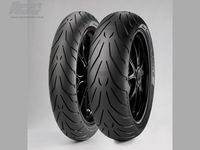The replacement for the previous generation Angel ST tire, Pirelli’s new Angel GT sport-touring tire, is claimed to offer up to 30 percent greater mileage, improved braking distances, and better grip and handling in the wet over the life of the tire. Some pretty big claims to be sure, but apparently a lot of R&D effort went into the new Angel GT’s design.
New tread patterns, both front and rear, provide more consistent wear characteristics and increased contact patch, along with better water drainage. The Angel GT’s profile was modified for a less rounded shape, which results in a contact patch that’s six percent shorter and 15 percent wider than the ST. In conjunction with new compounds, the shorter contact patch means less heat buildup and less movement of rubber over the pavement for less wear. On the other hand, the increase in contact width allows the GT to distribute weight over a larger area for more even wear. A new rayon-based construction works with a dualcompound rear and single compound front design (the front and rear shoulder compounds are 100 percent silica for excellent wet and dry grip) to provide better rigidity and more responsive handling while still offering good bump absorption characteristics.
For our Pirelli tires review, we spooned a set of Angel GTs onto our 2013 Yamaha FJR1300 test bike, a motorcycle that is notoriously hard on tires. The Pirellis immediately transformed the FJR's handling from the stock OE-spec Bridgestone BT-023s, giving it much more agile and precise steering manners; steering neutrality was impressive as well, even with the quicker handling. Feedback was good at moderate lean angles, though it was a bit less at aggressive lean compared with the stock rubber.
Overall grip on both wet and dry pavement was very good at all lean angles, and bump absorption and overall ride were much better than stock, with enough compliance to keep things smooth without feeling mushy; although when pushed hard, there was a bit of carcass movement. And after the same amount of mileage that killed off the stock tires, the Angel GTs have plenty of life left (especially in the center portion that has seen plenty of highway miles)—and their performance hasn’t degraded over time, either.
Details Pirelli Angel GT Retail: Front $191–$196; Rear $249–$286 www.pirelli.com

/cloudfront-us-east-1.images.arcpublishing.com/octane/H3EMT5NJ5BDZPBBH27SW3ADQH4.jpg)
/cloudfront-us-east-1.images.arcpublishing.com/octane/XTROSHDZFJB5DIJYU2VF2REFIU.jpg)
/cloudfront-us-east-1.images.arcpublishing.com/octane/7EUSM4GQEBEFTPAYZ6MOMKMMUQ.jpg)
/cloudfront-us-east-1.images.arcpublishing.com/octane/ZN44KZLHD5CHVIY3WZYAGTPGSI.jpg)
/cloudfront-us-east-1.images.arcpublishing.com/octane/5A776WXBY5GAPDYFTTUEUZNIJA.jpg)
/cloudfront-us-east-1.images.arcpublishing.com/octane/NCYHFQ2S3BAT7EC7VDN2ONGRTU.jpg)
/cloudfront-us-east-1.images.arcpublishing.com/octane/XQORS527YFFT3MVI326EOEYJUI.jpg)
/cloudfront-us-east-1.images.arcpublishing.com/octane/TVDPP3TGMZHODFXASIFUM2KD34.jpg)
/cloudfront-us-east-1.images.arcpublishing.com/octane/EWDMR3DDTBBQPI7DQVZCLMRFAE.jpg)
/cloudfront-us-east-1.images.arcpublishing.com/octane/4XHHLVOUKFE3PDSWNSV4JJMGOE.jpg)
/cloudfront-us-east-1.images.arcpublishing.com/octane/5RLI3NQKQJA3LKKCQHRXQFTL6Q.jpg)
/cloudfront-us-east-1.images.arcpublishing.com/octane/3QCYJCI2RNBENIRWAKEOEKHFUM.jpg)
/cloudfront-us-east-1.images.arcpublishing.com/octane/XJFFFMRN6VEZ7CDNAGKWVPC3H4.jpg)
/cloudfront-us-east-1.images.arcpublishing.com/octane/RMC3CHWSHFAUJA2WJ2FVG4NBOA.jpg)
/cloudfront-us-east-1.images.arcpublishing.com/octane/WXEZV4WAYBERFKSRE5M7GQBW7A.jpg)
/cloudfront-us-east-1.images.arcpublishing.com/octane/LO3PZVGICFGJZBNUA2ORUSAUSE.jpg)
/cloudfront-us-east-1.images.arcpublishing.com/octane/UFHLTNOXLVARVLZV32M6ZJZV4Y.jpg)
/cloudfront-us-east-1.images.arcpublishing.com/octane/CTSWNU7SNNCC3LWB2KATYZ5AXY.jpg)
/cloudfront-us-east-1.images.arcpublishing.com/octane/72EPJVNA2VGVXJ2BVDFFLN67KQ.jpg)
/cloudfront-us-east-1.images.arcpublishing.com/octane/A7C4GNXEHNHC3LL6RETG6MIPPY.jpg)
/cloudfront-us-east-1.images.arcpublishing.com/octane/Q4KZ7ACKF5BVTE56LMG7RPJCEM.jpg)
/cloudfront-us-east-1.images.arcpublishing.com/octane/RQ2CXG6ATJBUZGUR7NP35C3VBE.jpg)
/cloudfront-us-east-1.images.arcpublishing.com/octane/MWSEWNFALBBJHOQGZTUUPVOQOU.jpg)
/cloudfront-us-east-1.images.arcpublishing.com/octane/LTPXG4ZHCVFNDNILFQ6PN6YUKI.jpg)